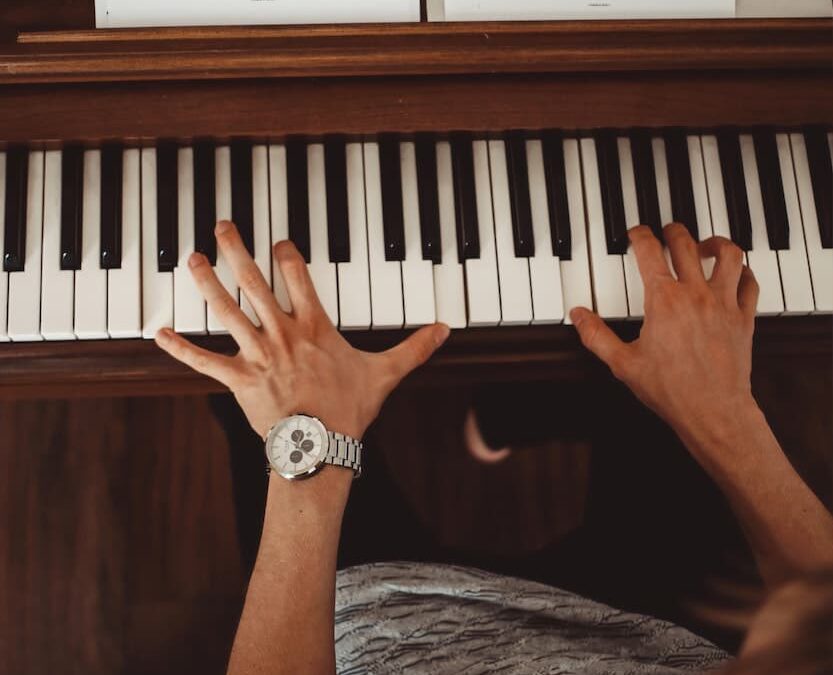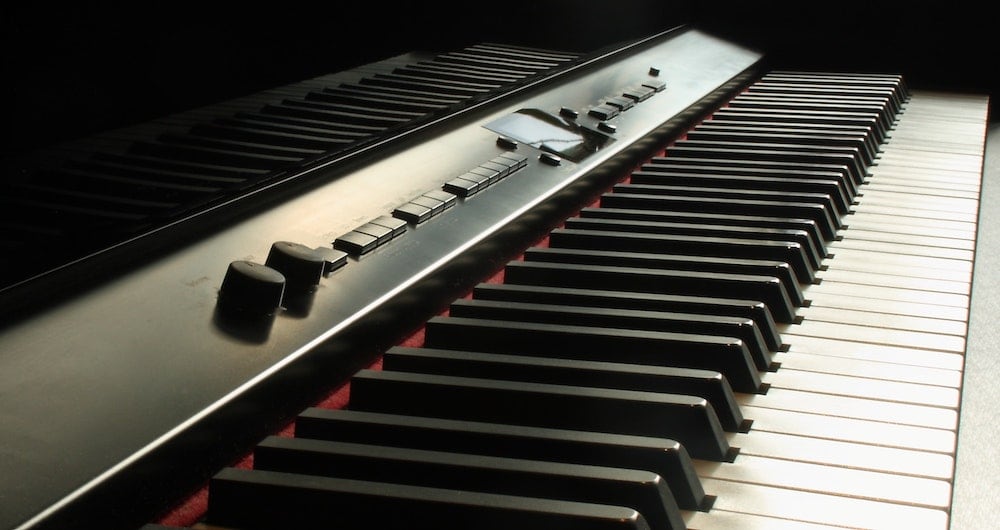How to learn songs by ear
I was around 13 years old and had been thinking about quitting my piano endeavors because, for the past six years, I was almost exclusively playing classical music, which as a kid I didn’t enjoy. As much as my classical training helped me develop my piano technique, my first love and initial enthusiasm for the music and piano faded. If it wasn’t for the day, I discovered there is a different way of learning how to play the piano I would probably quit altogether. Thankfully at that time, I found a new approach to learning and playing the music that I liked, which completely revolutionized the way I looked at the piano. So what’s the secret sauce? The title says it all. Learning songs by ear and slowly learning how to improvise on them, not only helped me to regain my love for the music but also started the next phase of my musical development.
Over the years, I came up with an approach on how to learn and play songs by ear. Playing by ear is a simple concept. It shouldn’t take you too long to start figuring out your first songs and melodies if you approach it correctly. Of course, as it is with any skill in order to master it, it will require quite a bit of practice, ear training as well as understanding music theory. To make the whole process easier to grasp I would recommend choosing a simple pop or folk song, or maybe even one of those notoriously well-known kids songs such as Twinkle, Twinkle, Little Star, or Mary Had a Little Lamb, etc.
Although playing by ear doesn’t require you to know a whole lot about music theory and piano, you need to know at least the basics such as:
- being able to name notes on the piano
- knowing what a major scale is (and how to build it)
- what are intervals in music and how to build chords
- what tonic note is, etc.
- being able to sing pitches of the notes correctly
Playing music by ear is a learnable skill, but you can’t be tone-deaf. Being able to compare different pitches is a necessary ability to learn this skill. If you are not sure about your ears, take this simple test (http://tonedeaftest.com).
If you have passed the test, you can be confident that you’re not tone deaf.
There is one more thing you should be able to do when learning how to play songs, and it is the ability to sing correct pitches of the notes you hear. In other words, to sing melodies. Of course, you don’t have to be a great singer to do this. Just make sure that when you hear a note, you can match the pitch of the note with your voice. If you are not confident that you can do it, download a tuner app into your smartphone or tablet. Next, sit down at your piano, play random notes (preferably in the middle section of the instrument due to a possible problem with a vocal range). Then sing the notes you just played to the tuner. Most likely you won’t be able to match the notes perfectly, but the pointer of the tuner should oscillate around them. If you can sing the notes correctly, great! It is a valuable skill to have when learning music by ear or when learning how to improvise.
How to learn songs by ear in 4 steps
To simplify and streamline the learning process, I’ve created a list of 4 simple steps to learn how to play by ear:
- Learn how to sing the melody of the song
- Figure out the key of the song (at first choose simple songs)
- Find the melody on the piano
- Learn the left-hand movemen
1. Learn how to sing the melody of the song
Before you start figuring out the melody on the piano, I highly recommend learning how to sing the melody first. If you wonder why, here is the reason. Concert pianist and music teacher George Kochevitsky in his book “The Art of Piano Playing: A Scientific Approach” has proven with scientific evidence that all music is played by ear – if you can’t hear it you can’t play it. That may surprise you, especially if you are classically trained and thought that playing by ear is not your avenue. Nonetheless, the evidence presented in the book shows the opposite. For this reason, it is highly recommended to start learning how to sing the melody without the instrument and internalizing it first. Don’t worry if you are not singing perfectly in tune, but make sure you are singing the right notes. Once you become familiar and comfortable singing the melody, you are ready to proceed to the next step.
2. Figure out the key of the song
Step no. 2 is quite important for two reasons:
- It will help you narrow down the number of possibilities when searching for the melody.
- It will allow you to play along with a recording of the song you are trying to learn.
As you probably know, each octave on the piano has 12 notes. By establishing the key of the song, you will narrow down the possibilities to 7 notes. Of course, there is always an exception to the rule! This is why I recommend beginning with simple songs, where it is unlikely that you will have to play outside of the key. In case you’re not trying to learn a song from a record but rather a song you already know, you can choose the key of your liking and proceed to step no. 3.
Before you start figuring out the melody on the instrument, we should establish the key of the song we are going to play in.
Here is how to do it.
a) Get in the groove
Play the record of the song you want to learn, listen carefully (but don’t strain your ears) and try to feel the music (because music is much more than just a bunch of notes :-)). Listening is the most important ingredient in finding the tonic, so don’t rush. While listening, try to hear the note in your head that feels like a place of rest towards which everything else gravitates. What we are doing here, is looking for a common tone of the song, also known as a tonic.
b) Try to sing the tonic of the song.
You are seeking a note that feels the most resolved when being hummed/singed. When you are arriving on the note, It should feel like you are returning home. Sometimes the tonic can be the first or the last melody note since it may create a feeling of rest or resolution. The tonic should be the note you can hum over the entire song, and it always works, other notes should gravitate towards it. Especially in the beginning stages, it’s quite common to mix up the tonic with the 3rd or the 5th note of the particular key. Here is my small tip on how to avoid it. When you feel confident you’re humming the tonic, try to sing from that note do-re-mi scale over the song you are trying to figure out. If it feels good and there is no dissonance throughout the scale, you are going to be right on the money!
c) Find the note on your instrument.
While sitting at your instrument hum the note, you’re trying to find. Pick a random note on the keyboard or the note you think will be the right one and play it. If you didn’t hit the correct note right away, don’t worry :). Start moving up the keyboard in half-step increments until you find the note you are humming. Did you find it? Awesome! Now move to the next step.
Note: If you are wondering, why did you have to go through steps a) and b) instead of jumping right to finding the note on your instrument, here is why. By performing the initial steps, we are training our ears to become more sensitive when comparing different intervals and improve the feel for the relationship between notes of a particular key. It is a basic ear training.
d) Play the scale to confirm you’ve been guessing correctly.
The last step in establishing the key is to play the scale of the particular key you’re in. Since most contemporary songs are written in a major key, you should know how to play all major scales (or at least know how to build them) to be able to determine the key. If it sounds dissonant, you’ve missed the tonic. But don’t worry, most likely you chose the 3rd or the 5th note of the particular key.
A quick tip: If you don’t know how to play a major scale in all 12 keys, here is a short formula on how to build them. First, you have to be able to distinguish between a whole step and a half step.
Half step (H) also called semitone (or minor second interval) is the smallest interval in western music. On the piano, half step is always the closest neighboring note (including black keys) to the one you play.
Whole step (W) consists of two semitones (half steps) and is always two keys away from the note you play.
Now that you know what a whole step and a half step is, build your major scale using this formula:
W – W – H – W – W – W – H.
3. Find the melody on the piano
If you’ve worked hard on learning the melody and determining the key of the tune, then finding the melody on your instrument shouldn’t be much of a problem. Since we already know the key of the song, the melody will likely be built upon the seven notes of the particular key. Similarly to the previous step, we are going to try to find the first note of the melody. We already know what the tonic sounds like, so the first thing we can do is to compare our tonic with melody note. Play the tonic and sing the first melody note. Is the melody note higher or lower pitch than the tonic? That should give us more information on where to seek the first melody note. By simple trial and error try out a couple of notes until you find the right one! It is ok if you don’t hit the right note at your first attempt, but keep close attention to the relationship of the tonic and the wrong note. It will give you more information on where to look for your melody note. Also, remember to sing the melody notes first and then try to find them on the instrument. By singing the melody, we can feel better how the melody is moving (higher tension in our vocal cord – higher notes, lower tension – lower notes). It will help you guide your hands in the right direction. If you have found your first note, move on to the remaining notes of the melody until you figure out all of them!
Essentially what we are doing here is a simple ear training exercise which allows you to internalize different intervals between notes. The goal here is to train your ear to be able to distinguish all kinds of intervals between notes automatically and intuitively.
4. Learn the left-hand movement
Now that we’ve covered, how to tackle the melodic part of the process, we can move on to supporting our melody with harmony in our left hand. There are multiple ways to approach this part of the process which varies in complexity. If your goal is to learn how to accompany yourself or someone else on the piano, it doesn’t have to be difficult. Of course, if you want to learn a complex jazz tune note for note (including left-hand movement), it can become a challenging task to do. A good prerequisite for learning how to hear the bass part is our previous step, so make sure you are confident learning how to sing melodies as well as quickly finding them on your instrument. Also, you should know how to build chords (at least major and minor) as without this knowledge it could become a daunting task when trying to figure out each note of a bass part by ear.
Steps to learn the left-hand movement:
a) Listen carefully to the bass part or the lowest note.
Yes, it is that simple! To determine the quality of the chord you have to tune in to the bass part or the lowest note (in case there is no bass player) of the song. By determining the lowest note, we are establishing our root note of the chord. When you’re looking for the root notes, be aware that most bass players not only play the root note of the chord but also passing tones between chords, to create more interesting bass lines. In this stage of the process, we are not interested in the passing tones, what we want to focus on are the bass notes where harmony changes within all of the instruments. As simple as it may sound hearing a bass part is definitely more difficult than hearing a melody. Aspects such as mix, arrangement, or instrumentation of the song can make it less distinguishable. Make sure to write down a couple of notes or even better one section of the bass part of the song (for example first verse) before you progress to the next step.
Tip: If you are having a hard time hearing the bass part, here are two basic tricks I would recommend.
- Boost up the bass – probably every music player these days has an equalizer. So in case, the recording lacks some low end try to boost it!
- Use software to slow down the song you are working on. There are many players with the ability to slow down the song; some work better than others. The best free option for Mac users that I found is Garageband. If you are the owner of a Logix Pro X, even better.
I use Capo App for Mac, which I find has a lot of extra features such as the ability to:
- automatically detect chords
- isolate a specific frequency range
- transpose a song to a different key signature
The algorithm for slowing down the song is excellent and makes the sound very smooth and fluid without any jitter. If you plan on transcribing a lot of music, I would definitely consider purchasing this app.
As amazing as the slow down software might be, I would not recommend overusing it. The reason is simple. By transcribing music solely from the record, you are training your ear to catch all the details of the song in real-time. This is an especially helpful skill to have when playing improvised music with your friends or bandmates. Every musician should strive to have the ability to respond to musical ideas of your bandmates during live gigs, so 99 % of our practice should be in “real-tempo” scenario.
b) Determine the quality of the chord
If you are confident that you have your root notes written down correctly, you can start trying out different chord qualities based upon root notes. Most common chord qualities in a style of pop, folk or worship are major and minor chords, so I would recommend starting with those two. If you have tried to play the melody with major or minor chords in your left hand, but they don’t fit in, go ahead and try different chord types such as:
- diminished
- augmented
- half-diminished
- etc.
I’ve created a simple list of chord formulas so that you can create them on the fly.
1 … the root note
2 – 7 … intervals between the root of the chord and the other notes
“b” … lowering a particular note by a semitone,
“#”… raising a particular note by a semitone
You can go even further and simplify your accompaniment with the root and the fifth in your left hand (aka perfect fifth). Try to play it along with the melody in the right hand. There are two advantages of this simplified approach. First, by playing a root and the fifth, we are not establishing the chord quality with our left hand, because in this case, it is the melody in our right hand which gives us the harmonic context. This allows us to quickly try out whether or not the melody works within the context of our left hand. Besides that, it is a quick and simple way how to familiarize yourself with the song. There is a greater chance that the melody is going to work in this context because by omitting the 3rd and the 7th your left hand becomes a foundation of different kinds of chords such as major, minor, suspended or dominant. The second reason to use the perfect fifth in your left hand is that it creates more “open sound” compared to traditional major triad chords.
Furthermore, I found that the lower you go with your voicings on the keyboard, the wider you want your intervals to be. Otherwise, they start to sound muddy and unclear. For this reason, I do not recommend using triadic chords built by superimposing thirds on top of each other.
c) Familiarize yourself with a common chord progression of a particular style.
Most musicians would agree that music is a language. Whether we use the language to talk about medicine, technology, art, or anything else, each field has its own vocabulary pool. Similarly, each style of music has a common music vocabulary, phrases, rhythms, chord progressions, etc. For example, in case you are interested in pop, very soon you will come across I-IV-V or I–V–vi–IV progressions as those are very common in this particular idiom. Literally, thousands of songs are written with them. In jazz, the most often used cadence is the ii-V-I progression. If you are wondering why it is helpful to familiarize yourself with common progressions of different music styles, the reason is simple. Music is a very broad term, and in theory, there is a countless number of possible chord progressions. In reality, most songs use the same handful of progressions. To simplify the process of learning songs by ear, it is good to know the most common progressions, as it helps you to narrow down the number of possibilities.
CONCLUSION
Learning how to play songs by ear is easily the most valuable skill I’ve developed over the years. It is not a skill you can master overnight. You will need to invest a lot of time to learn and perfect this ability, but it is definitely worth it. If I had to point out the most important aspects of this process, I would emphasize learning how to sing the melody of a song as well as learning common chord progressions.
Since the melody is the heart of the song, you want to train your ear to grasp new melodies quickly. Having the ability to reference your friend’s licks and melodies with your instrument during a live performance creates a deeper connection between you and your bandmates, which ultimately makes up for an authentic and more interesting experience for the listener.
The second most important thing when learning songs by ear is being familiar with common chord progressions and cadences of a particular style/genre you are playing in. Since there are literally thousands of possible chord progressions, you want to know the most commonly used ones. It will help you to narrow down the number of possibilities and speed up the learning curve.
If you have any helpful suggestions on improving this article or want to share tips about how you learn songs by ear, I’ll be happy to hear from you.

Welcome to my blog!
Hi, I’m Kuba! Music, instruments and piano has been a big part of my life for quite some time (actually over 20 years)! I come here and write about what I’ve lerned, gear or anythings else piano related. I hope you will find this site helpful.
Other Articles

Worship piano: the ultimate guide for beginners
If you're anything like me, then you probably consider music to be one of the most amazing gifts from God. As a kid, I wasn't always excited about attending the Sunday service, but I remember that the time of praise and worship was my favorite part of the service, and...

7 Ways to Make Your Chords More Interesting (tips for piano beginners)
Probably all of us face moments when we reach a plateau in our playing. Those are times when it's a good idea to seek out some inspiration to overcome the rut. If you're bored of playing the same chords over and over again, wondering how to make your chords sound more...

Best digital piano for church
If you are looking for a digital piano for your church, you might be wondering what are the key factors and features I should consider before the purchase? There are dozens of factors you can take into account, but not all of them are equally important.I've been...
Related Article
Worship piano: the ultimate guide for beginners
If you're anything like me, then you probably consider music to be one of the most amazing gifts from God. As a kid, I wasn't always excited about attending the Sunday service, but I remember that the time of praise and worship was my favorite part of the service, and...

